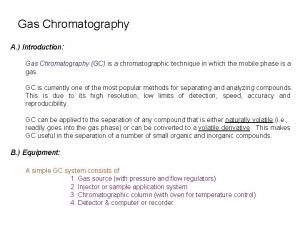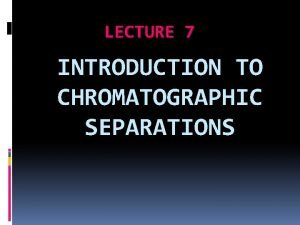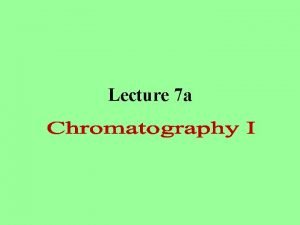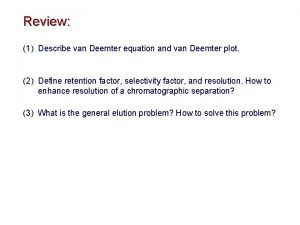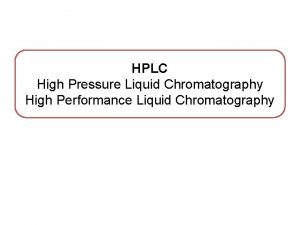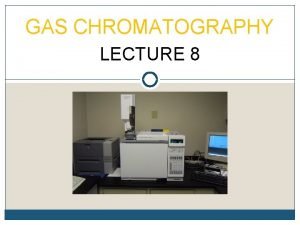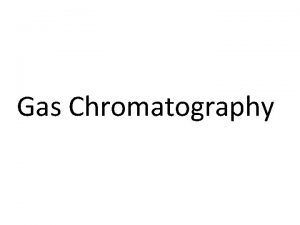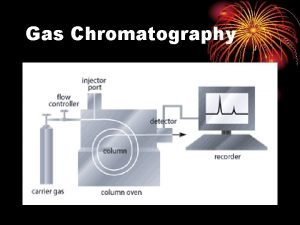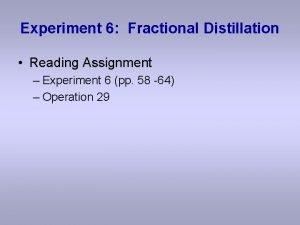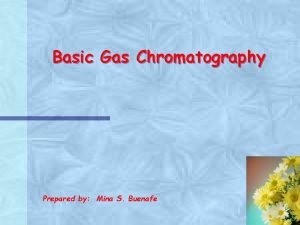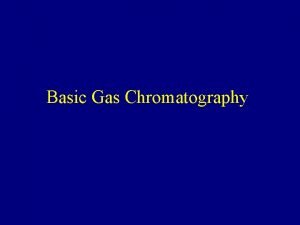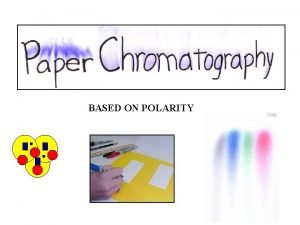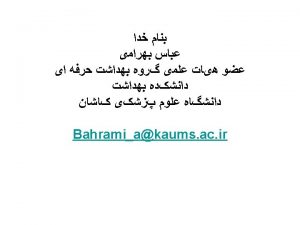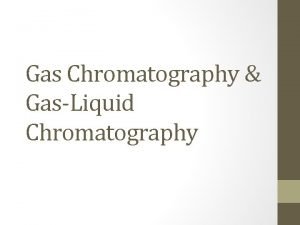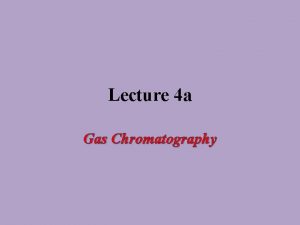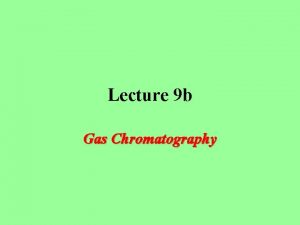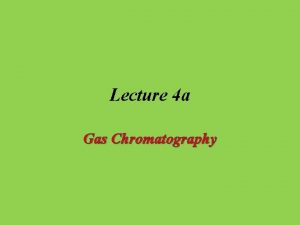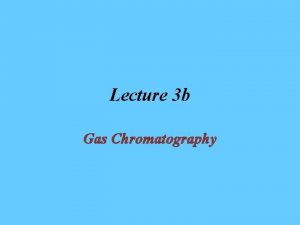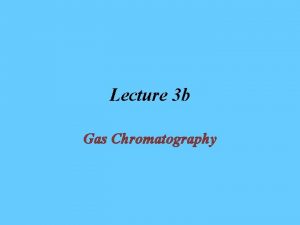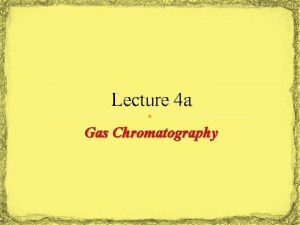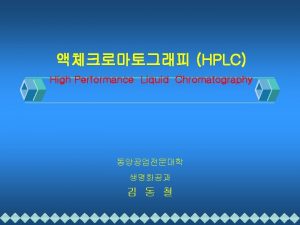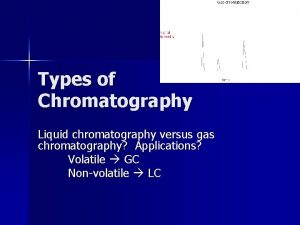Lecture 4 a Gas Chromatography Introduction Gas chromatography













- Slides: 13

Lecture 4 a Gas Chromatography

Introduction • Gas chromatography is used in many research labs, industrial labs (quality control), forensic (arson and drug analysis, toxicology, etc. ), environmental labs (water, soil, air), and even in the popular TV culture (crime shows like NCIS (Major Mass Spec), CSI, etc. ) – Used for the quantitation of compounds – Often combined with a mass spectrometer for identification using the fragmentation (by comparison with literature spectra) • Traditional equipment requires the use of compounds that are stable enough to be vaporized without decomposition – Mainly useful for small or non-polar molecules but not for large molecules i. e. , proteins, polymers, etc. – Sometimes polar molecules can be converted into derivatives by using i. e. , trifluoromethylacetyl groups (F 3 CC≡O) to increase their volatility

Basic setup • Parts: Injection block, column, oven, detector, carrier gas, computer system • The temperature of the injection block has to be above 200 o. C to ensure a rapid and complete evaporation of the injected sample • The temperature of the detector has to be 20 -30 o. C above the final column temperature to prevent condensation of the compounds

Theory of Gas Chromatography I • • The separation of compounds in a mixture is based on different polarities in a direct (interaction with stationary phase i. e. , solubility) or indirect way (physical properties i. e. , boiling point) The gas chromatography column consists of solid support that is covered with a high-boiling liquid in a thin capillary tube In the example above, compound “X” has a higher affinity towards the stationary phase compared to compound “O” Compound “O” elutes before compound “X” because it displays a lower boiling point and a weaker interaction with the stationary phase O ‖ time X

Theory of Gas Chromatography II • What influences the outcome in the GC run? – The boiling point of the compound • The higher the boiling point is, the slower the compound is going to migrate through the column resulting in a longer retention time – The polarity of the compound compared to the polarity of the column • The stronger the interaction of the compound with the stationary phase is going to be, which increases the retention time – The column temperature • A lower temperature allows for more interaction of the compound with the stationary phase resulting in longer retention times with improved separation

Theory of Gas Chromatography III – Carrier gas flow rate • A higher flow rate allows for less interaction of the compound with the stationary phase resulting in shorter retention times with poorer separation – Column length • A longer retention time with better separation will be observed but also peak broadening due to increased longitudinal diffusion – Amount of the material injected • If too much material is injected, close peaks will overlap, which makes the identification (i. e. , mass spectrometry) and the quantitation of the compounds more difficult if not impossible – The conditions have to be adjusted for each separation problem, which will be very difficult if the compounds to be separated have similar very properties. The goal is to optimize the separation and the retention time for a given separation problem.

Detectors I • FID (Flame Ionization Detector) – Advantages: • It is very sensitive for most organic compounds (1 pg/s, DLL: 0. 1 ppm) • Low sensitivity for small molecules i. e. , N 2, CO 2, H 2 O – Disadvantages: • The sample is destroyed • It requires three gases (carrier gas (i. e. , helium, argon, nitrogen), hydrogen and air/oxygen)

Detectors II • TCD (Thermal Conductivity Detector) – Advantages: • The sample is not destroyed and can be collected after passing through the column • Only one gas with a high thermal conductivity needed i. e. , helium, hydrogen – Disadvantages: • The method possesses a significantly lower sensitivity compared to FID (usually 2 -3 magnitudes, DLL: 10 ppm) • ECD (Electron Capture Detector) – Advantages: • It is very sensitive for chlorinated compounds i. e. , TCDD, PCB, etc. and organometallic compounds (DLL: 0. 1 ppb) – Disadvantages: • Since a radioactive source is used, a special license and area is required for its operation • Several carrier gases needed for the ionization i. e. , argon/methane

Sample Identification • Mass spectrometer • Spiking: the sample is run with and without the addition of a spike, which is an authentic sample of compound to be identified • Original spectrum A B • Spike B added • If compound A was added as the spike, peak A would increase in area • If the spike that was added to the mixture was not a compound in the mixture, an additional peak would be observed • This method is semi-quantitative

Analysis of Gas Chromatogram I • Complete spectrum (HP-5, weakly polar, achiral) • The GC spectrum is dominated by the solvent peak • The peak for (-)-isoborneol and (+)-borneol are not visible in the full spectrum because of their low concentration (1 mg/m. L)

Analysis of Gas Chromatogram II • Expansions Expanded further

Chiral GC Column • Modified version of b-cyclodextrin (Column: Restek (Rt-b. DEXse), 30 m x 0. 32 mm x 0. 25 mm, Conditions: Ti=85 o. C, isothermal) Isoborneol Rt-b. DEXse, 30 mx 0. 32 mmx 0. 25 mm, Ti=85 o. C, isothermal Borneol (+)-isoborneol (-)-isoborneol • Peak areas in pairs are identical racemic • The assignments of the enantiomers were made on the reduction product of D-(+)-camphor that yields a mixture of (-)-isoborneol and (+)-borneol (-)-borneol (+)-borneol

Elution Sequence Compound p(351 K, 78 o. C) p(431 K, 158 o. C) camphor 1. 07 mm. Hg 25. 7 mm. Hg isoborneol 1. 68 mm. Hg 24. 1 mm. Hg borneol 0. 30 mm. Hg 17. 4 mm. Hg • Camphor displays the highest vapor pressure of the three compounds at T=158 o. C, a temperature that is close to the average temperature of the GC run (140 to 180 o. C). • Based on the vapor pressures, one can predict an elution sequence at temperatures above T=158 o. C: camphor, isoborneol and borneol
 Gas chromatography
Gas chromatography 01:640:244 lecture notes - lecture 15: plat, idah, farad
01:640:244 lecture notes - lecture 15: plat, idah, farad Chromatography lecture
Chromatography lecture Chromatography was discovered by
Chromatography was discovered by Van deemter equation for capillary gc
Van deemter equation for capillary gc Difference between isocratic and gradient elution
Difference between isocratic and gradient elution Fid detector principle
Fid detector principle Basic principles of gas chromatography
Basic principles of gas chromatography Gas liquid chromatography
Gas liquid chromatography Percent composition gas chromatography
Percent composition gas chromatography Chromatography mobile phase and stationary phase
Chromatography mobile phase and stationary phase Basic gas chromatography
Basic gas chromatography Gas chromatography history
Gas chromatography history Column chromatography youtube
Column chromatography youtube
